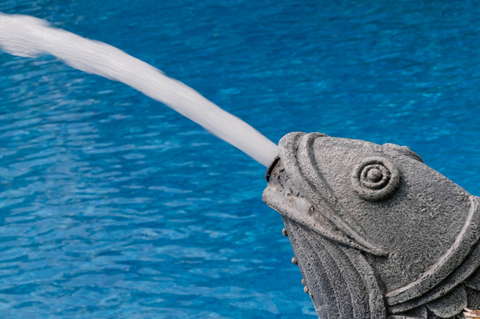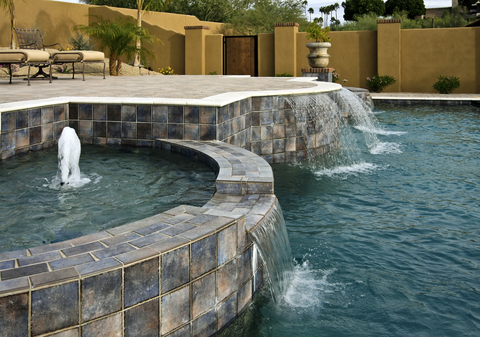Pumped-Up Savings

Through the years, professional watershapers have learned that good hydraulic design can significantly increase system efficiency while lowering the ongoing costs of operation. Now they’re also recognizing that achieving these efficiencies and finding these savings are perceived as “going green” – a key to helping commercial-facility managers and homeowners justify their investments in pools, spas and other waterfeatures.
Until fairly recently, good hydraulic design was mainly about using big pipes and matching them up with the smallest pump appropriate to the given application. Lately, however, the pathway to optimal performance carries you to variable-frequency drives, which give system designers far greater control over energy consumption and operating costs than they ever had before.
To achieve best-possible reductions in energy consumption and the associated expenses of running water circulation and filtration systems, it’s important to understand why pumps and filters consume so much energy and how this new technology helps bring those exertions under control. As the industry’s experience with variable-frequency drives grows, it’s also time to consider a pump motor’s service life and how the new technology affects it.
Let’s dig in and explore the advantages of variable-frequency drives – and see how they’re leading us to “greener” paths.
VARIABLE DYNAMICS
As indicated above, variable-frequency drives (VFDs) are key players in watershaping’s push toward greater efficiency. When used in conjunction with suitable three-phase motors, these devices allow a pump to run at its most efficient point on the performance curve, whatever that may be at any given time.
This alone is a huge contribution to system efficiency, but there’s more: VFDs also serve as a motor-protection system, with a slow, ramp-up start that decreases the water-hammer effect that can damage the motor’s shaft and the pump’s impeller. They also reduce the start-up pressure applied to the overall plumbing system.
 And more: Among a VFD’s best features, it “cleans” the power going to the system, giving the motor exactly what it needs by way of consistent, solid current and thereby increasing the motor’s service life. As for the pump, a VFD dials onto exactly the required flow rate – much more effective than using butterfly valves or other external components to bring the flow within specifications.
And more: Among a VFD’s best features, it “cleans” the power going to the system, giving the motor exactly what it needs by way of consistent, solid current and thereby increasing the motor’s service life. As for the pump, a VFD dials onto exactly the required flow rate – much more effective than using butterfly valves or other external components to bring the flow within specifications.
The list of benefits goes on: Most VFDs eliminate the need for motor starters because they’re built into the drive. In cases where starters would be purchased separately (as is true with large commercial pumps), this can represent an immediate savings of $500 to $750 per pump. And they include surge-protection systems that keep voltage spikes and phase imbalances from harming the motor.
It’s often said that installing a VFD with a pump will immediately save as much as five or ten percent of the energy cost of running a pump, and that’s true – but experience is teaching us that that’s just the beginning. In fact, when all is said and done, a VFD brings in savings at a rate closer to 60 percent when service-life, maintenance and deferred replacement costs are added to the basic energy savings.
MAKING CHOICES
To chart savings at that level, you have to know exactly what it costs to run a system – something that’s common in commercial projects but is seen less frequently in residential ones.
To find such a figure, you must know the pump’s flow in terms of gallons per minute and the system’s total dynamic head; how long the pump needs to run each day to achieve the desired turnover rate; and the cost of energy per kilowatt-hour as charged by the local power company. Once you’ve run the calculations and generated a dollar figure, you will easily be able to figure out how quickly a VFD system will pay for itself.
If that calculation is persuasive – and it invariably is – it’s time to get specific:
[ ] Step 1: Choose a VFD. This is the simple part: All you need to know is the horsepower of the three-phase motor and pump with which the VFD will operate and where the drive will be installed (indoors or out). The greatest potential for savings comes when a VFD is used with a motor with Class F insulation. (If it’s a Class B unit, the drive can still be used, but additional software may be needed, depending on the incoming voltage.)|
Reducing Costs in Ten Steps 1. Replace the existing pool pump with an energy-efficient unit. — M.F. |
Finding the right pump for a given application is a familiar process: Determine the flow rate in gallons per minute; calculate total dynamic head (that is, the pressure/head difference between the inlet and outlet of the pump) to account for friction loss; add 20 feet of head to compensate for a dirty filter (optional); and refer to pump-performance curves and select the appropriate unit. If the plotted point falls between two pump sizes, select the larger size.
Finally, double check your calculations and results, verifying that the selected filter can handle the system’s flow rate and that minimum backwash flow rates can be achieved.
COUNTING THE WAYS
As our experience with VFDs increases, we’re finding that factors we weren’t considering up front are as important in the long run as are the immediate energy savings these units can achieve.
Indeed, the greatest long-term benefit of a VFD may well be that it significantly lengthens the service life of the motor it controls. The importance of ramping up the start can’t be overstressed, nor can the value of the protection a VFD offers the motor with respect to voltage surges or phase imbalances.
We all assumed right away that savings on energy costs would be a big deal with VFDs, but now we’re seeing that installing VFDs helps motors work far better for far longer – “green” indeed!
Mike Fowler is the commercial marketing and sales manager for Pentair Aquatic Systems in Sanford, N.C. He has been with Pentair since 1992, starting his career in the technical services department at Purex Pool Products. Fowler has held many managerial roles within the company, including marketing, accounting and products. He can be reached via e-mail at [email protected].










